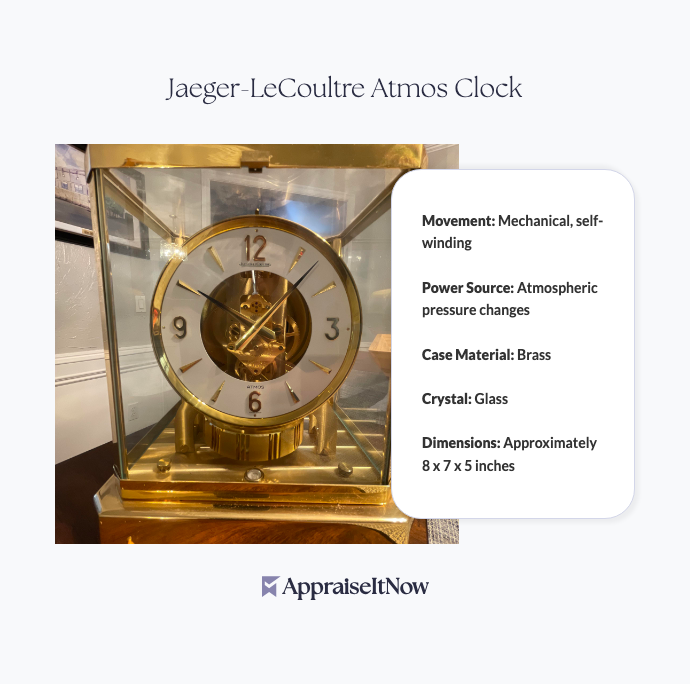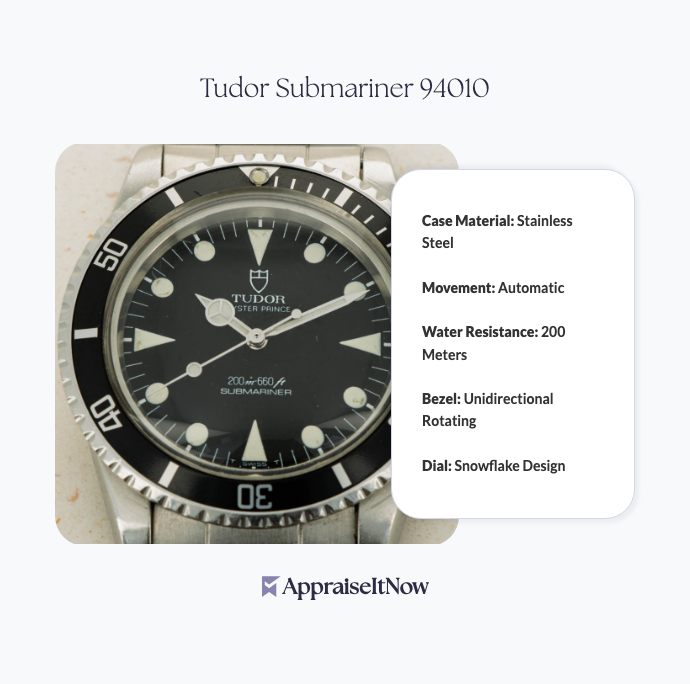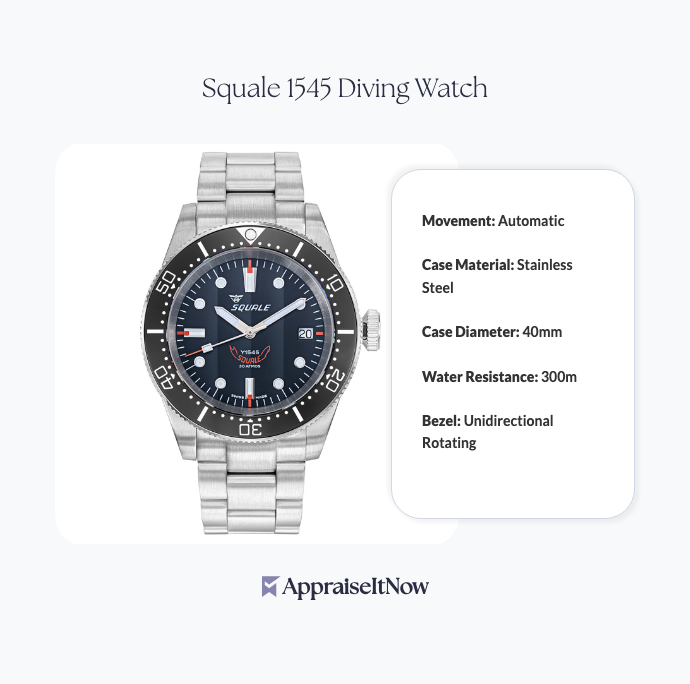<h1>How to Get Your Jaeger-LeCoultre Atmos Clock Appraised</h1>
<p>The Jaeger-LeCoultre Atmos Clock stands as one of the world's most extraordinary timepieces—a self-winding marvel that draws energy directly from atmospheric pressure changes and temperature fluctuations. Whether you've inherited one, are considering a purchase, or simply want to understand your clock's current market value, getting a professional appraisal provides the clarity and documentation you need. With an estimated market value between <strong>$8,000 and $15,000</strong>, these iconic Swiss instruments deserve expert evaluation.</p>
<h2>Understanding What Makes Your Atmos Clock Valuable</h2>
<p>Your Atmos Clock's worth stems from a combination of engineering brilliance, historical significance, and scarcity. First introduced in <strong>1928</strong> by Jaeger-LeCoultre, the Atmos represents over a century of Swiss precision craftsmanship. The clock's revolutionary perpetual mechanism requires no winding or electrical power—instead, it harnesses tiny variations in barometric pressure to maintain accurate timekeeping for decades, sometimes for over a century without intervention.</p>
<p>This engineering achievement has made the Atmos highly sought-after among horologists, design enthusiasts, and collectors who recognize it as more than a timekeeping device. It's a functional sculpture that combines art with mechanical innovation. The fact that only <strong>500 pieces are produced annually</strong> by Jaeger-LeCoultre maintains scarcity that supports strong market value. When evaluating whether Atmos clocks are worth the investment, consider that these instruments typically appreciate steadily rather than depreciate, similar to how other fine Swiss timepieces hold value over time.</p>
<div class="callout tip"><p><strong>Collector's Insight</strong></p>
<p>Atmos Clocks with documented provenance and original packaging can command 15-20% premiums over standard market estimates, making ownership history crucial for valuation.</p></div>
<h2>Key Factors Appraisers Examine When Valuing Your Atmos</h2>
<p>Professional appraisers specializing in collectible timepieces focus on several critical elements when determining your Atmos Clock's specific value within the $8,000-$15,000 range. Understanding these factors helps you appreciate why professional appraisal matters for items in the <a href="/types/memorabilia-and-collectibles">memorabilia and collectibles</a> category.</p>
<p><strong>Manufacturing year and model variant</strong> significantly impact value. Atmos clocks from the 1920s-1960s command premium pricing compared to later models, though all modern examples maintain strong market positions. Serial number documentation allows appraisers to pinpoint exact production dates and verify authenticity. <strong>Original condition and case material</strong> matter considerably—clocks housed in original brass, platinum, or specially finished cases are valued higher than those in basic configurations. The Atmos features a distinctive sapphire crystal case back that allows viewing of the remarkable mechanism inside; any damage to this crystal reduces value substantially.</p>
<p><strong>Mechanical function and accuracy</strong> remain central to valuation. A properly functioning Atmos that maintains accurate time within acceptable parameters commands full market value, while clocks requiring service may see 10-30% reductions pending repairs. Appraisers test the perpetual mechanism's responsiveness to atmospheric changes and verify that the mercury-compensated pendulum operates correctly. Original accessories—authentic Jaeger-LeCoultre documentation, original boxes, or period-appropriate display cases—enhance value and provide important provenance evidence.</p>
<h2>Dating Your Atmos Clock and Establishing Provenance</h2>
<p>One of the most frequent questions collectors ask is how to date an Atmos clock accurately. The serial number tells the complete story. Jaeger-LeCoultre maintains comprehensive production records, and certified appraisers can access this information to establish exact manufacturing dates. Early Atmos models (1928-1950) are historically significant and command premium pricing, while 1960s-1980s examples represent excellent value for collectors seeking functional perpetual mechanisms at moderate price points.</p>
<p>Understanding your clock's history beyond the serial number strengthens its appraisal value. If you know previous owners, can document where it was purchased, or have any correspondence related to the clock's acquisition, these materials provide crucial provenance documentation. Family inheritance stories matter less than documented proof of authenticity and ownership transfer, which professional appraisers weigh carefully when establishing fair market value. This mirrors how <a href="/blog/exploring-the-role-of-provenance-in-art-appraisals-assessing-historical-significance">artwork appraisals</a> emphasize historical significance and documented ownership chains.</p>
<h2>What Makes Jaeger-LeCoultre More Prestigious Than Rolex</h2>
<p>Collectors frequently ask whether JLC holds value better than other luxury watch brands and whether Jaeger-LeCoultre is as respected as Patek Philippe. The answer involves understanding the distinct market positioning of these Swiss houses. While <strong>Rolex</strong> focuses on sports watches with robust accessibility, Jaeger-LeCoultre represents ultra-luxury and technical innovation at a more exclusive level. The brand's founder, Jacques-David LeCoultre, pioneered precision measurement techniques that fundamentally advanced watchmaking globally.</p>
<p>The Atmos Clock specifically demonstrates this prestige—no competing Swiss manufacturer has created a successful competing perpetual mechanism that matches the Atmos's longevity and reliability. When comparing JLC to Patek Philippe, both command extreme loyalty and investment premiums, but they serve different collector interests. Patek Philippe excellence centers on portable timepieces and complications, while Jaeger-LeCoultre's Atmos represents stationary precision and revolutionary engineering. This distinction helps explain why Atmos Clocks are rarely subject to market downturns affecting other collectibles.</p>
<div class="callout note"><p><strong>Market Insight</strong></p>
<p>Jaeger-LeCoultre holds value differently than Rolex—rather than strong resale markets for everyday wear, JLC attracts collectors seeking technical mastery and engineering prestige, supporting steady appraisal values.</p></div>
<h2>Condition Assessment and Its Impact on Your Atmos Value</h2>
<p>If you're wondering how to know if your clock is worth money and how its condition affects that worth, condition assessment provides the definitive answer. Professional appraisers use standardized grading systems when evaluating collectible timepieces, examining multiple condition aspects that accumulate to determine overall market positioning.</p>
<p>The clock's external appearance matters significantly. Original finish, absence of scratches or dents, and intact sapphire crystal all support higher valuations. Internal mechanical condition—whether the perpetual mechanism responds properly to atmospheric pressure changes, whether the escapement operates smoothly, and whether the movement's jewels and pivot points remain clean—affects both functionality and value. A clock requiring full servicing may be appraised at the lower end of the $8,000-$15,000 range, while an example in excellent condition with confirmed accurate operation commands premium positioning.</p>
<table class='appraisal-table'>
<thead>
<tr>
<th>Condition Grade</th>
<th>Typical Value Range</th>
<th>Key Characteristics</th>
</tr>
</thead>
<tbody>
<tr>
<td>Excellent (95%+)</td>
<td>$13,000-$15,000</td>
<td>Original condition, fully functional, minimal wear</td>
</tr>
<tr>
<td>Very Good (80-94%)</td>
<td>$11,000-$13,000</td>
<td>Light wear, fully functional, original components</td>
</tr>
<tr>
<td>Good (65-79%)</td>
<td>$9,000-$11,000</td>
<td>Moderate wear, fully functional, possible minor service needed</td>
</tr>
<tr>
<td>Fair (Below 65%)</td>
<td>$8,000-$9,000</td>
<td>Heavy wear, functional but service recommended</td>
</tr>
</tbody>
</table>
<h2>Preparing Your Atmos Clock for Professional Appraisal</h2>
<p>Getting an accurate appraisal begins with thoughtful preparation. Gather any documentation you possess—original boxes, certificates of authenticity, service records, family letters discussing the clock's provenance, or photographs showing the clock in different settings. This supporting material, even anecdotal family history, provides context that professional appraisers value when assessing authenticity and establishing fair market positioning.</p>
<p>Avoid cleaning or servicing your clock immediately before appraisal unless it's clearly non-functional. Appraisers need to evaluate the clock in its current authentic state, not its post-restoration condition. If your Atmos hasn't run for years, mention this when scheduling your appraisal—the appraiser can factor in likely service costs while still providing accurate fair market value estimates. Photograph your clock from multiple angles, including close-ups of any maker's marks, serial numbers, or distinctive features, to provide appraisers with detailed visual reference before an in-person evaluation.</p>
<p>Professional appraisal services like <strong>AppraiseItNow</strong> accept photographic submissions along with detailed descriptions, allowing initial assessment before more intensive evaluation. This approach applies to <a href="/types/personal-property">personal property appraisals</a> across categories, ensuring efficient, accurate valuation processes.</p>
<h2>Where and How to Sell Your Jaeger-LeCoultre Atmos Clock</h2>
<p>Understanding where to sell your Atmos Clock matters when you decide to monetize your investment. Several channels exist, each with distinct advantages and buyer demographics that affect final selling prices. Specialized auction houses focusing on scientific instruments and precision timepieces often attract serious collectors willing to pay premium prices for documented, well-preserved examples. General auction platforms like Christie's or Sotheby's occasionally feature Atmos Clocks but typically generate less competitive bidding than specialized venues.</p>
<p>Private sale channels—whether through collector networks, horological societies, or direct buyer engagement—often yield stronger prices than auction houses, since you avoid commission structures eating into proceeds. Online platforms connecting collectors have expanded dramatically, creating new market opportunities. Having a certified appraisal before listing your clock provides potential buyers confidence and supports premium positioning. This documentation strengthens your negotiating position regardless of sales channel chosen.</p>
<div class="callout tip"><p><strong>Pro Tip</strong></p>
<p>Sellers with certified appraisals command 10-15% higher prices than those offering only personal assessments, since buyers gain confidence in condition and authenticity claims.</p></div>
<h2>When Should You Get Your Atmos Clock Appraised?</h2>
<p>Professional appraisal timing depends on your specific circumstances. If you're buying an Atmos Clock, pre-purchase appraisal protects your investment and verifies you're paying fair market value. When inheriting a clock, appraisal establishes documented value for estate distribution and tax purposes—requirements that apply across <a href="/types/household-goods">household goods</a> and <a href="/types/personal-property">personal property</a> categories. For insurance purposes, annual or biennial updates ensure your coverage reflects current market values, particularly important given steady appreciation in vintage Atmos markets.</p>
<p>If you're considering selling, appraisal establishes realistic asking prices and demonstrates to potential buyers that you understand the market. Estate planners frequently recommend appraisals when clients have significant collectibles, ensuring proper valuation for distribution and tax documentation. The investment in professional appraisal—typically $200-500 depending on complexity and appraiser credentials—returns itself many times over through accurate market positioning, tax efficiency, and confidence in major transactions.</p>
<p>Learn more about <a href="/blog/tips-for-obtaining-accurate-personal-property-appraisals">tips for obtaining accurate personal property appraisals</a> to understand the broader appraisal process.</p>
<h2>Jaeger-LeCoultre's Legacy and Continued Prestige</h2>
<p>Understanding JLC's prestige helps explain your Atmos Clock's strong market position. The manufacture creates timepieces for an exclusive clientele globally, maintaining strict production limits that support consistent value. Are Atmos clocks still made? Yes—Jaeger-LeCoultre continues producing Atmos clocks today, maintaining the same exacting standards that have defined the brand since 1833. Current production ensures the mechanism remains refined and improved while honoring original design principles.</p>
<p>This ongoing manufacturing commitment, combined with the brand's centuries of horological achievement, distinguishes Jaeger-LeCoultre in global markets. When celebrities, billionaires, and serious collectors ask about the best precision timepieces available, Jaeger-LeCoultre invariably ranks among top recommendations. The brand's museum-quality craftsmanship, innovation heritage, and engineering excellence create what what appraisers call "brand premium"—the pricing advantage that JLC maintains across its product categories.</p>
<h2>Special Considerations for Atmos Clock Appraisal</h2>
<p>Appraisers specializing in <a href="/blog/appraising-luxury-watches-determining-the-value-of-timepiece-investments">collectible timepieces</a> understand nuances that generalist appraisers may miss. The distinction between different Atmos model variants, understanding how mercury-compensated pendulums function, recognizing authentic versus reproduction cases, and knowing the specific production history of your clock's serial range requires specialized knowledge.</p>
<p>Are all Atmos clocks gold plated? No—Atmos clocks appear in multiple case materials and finishes depending on production year and original market positioning. Some early examples feature precious metal cases (platinum, gold), while others use quality base metals with attractive finishes. This material specification significantly affects value, making expert evaluation essential. Professional appraisers can immediately identify case materials through visual inspection and material testing, establishing accurate valuations based on specific specifications.</p>
<div class="callout note"><p><strong>Key Takeaway</strong></p>
<p>A certified appraisal of your Jaeger-LeCoultre Atmos Clock from a credentialed specialist provides accurate valuation, authentic documentation, and the confidence that your remarkable timepiece is properly understood and positioned in today's market. Whether you're buying, selling, insuring, or simply documenting your collection, professional appraisal transforms uncertainty into clarity and protects your investment in this engineering marvel.</p></div>







.avif)







